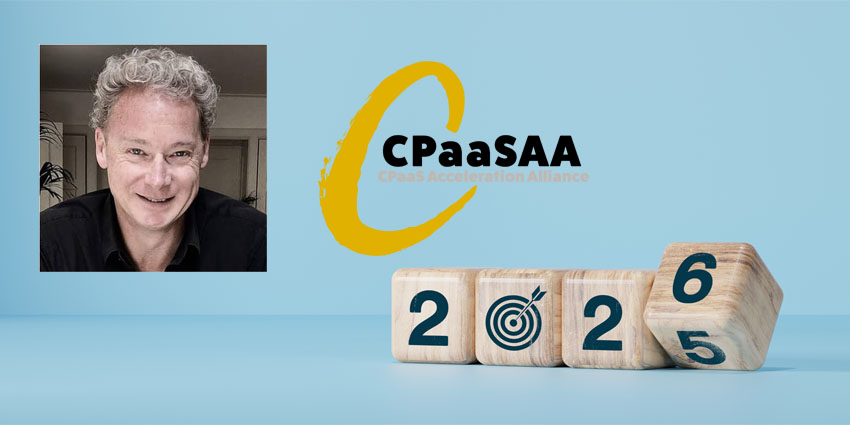For decades, enterprise communications evolved in slow, predictable increments, from copper lines to cloud PBXs, and from call centers to omnichannel contact hubs. Today, the pace feels almost reckless. AI has entered the conversation in a dramatic fashion, both literally and figuratively, transforming how organisations listen, speak, and respond. That’s what makes the intelligent engagement evolution of CPaaS so significant.
Few people have a clearer view of this inflection point than Rob Kurver, Founder of the CPaaS Acceleration Alliance (CPaaSAA). Fresh from hosting the first CPaaS Acceleration Summit Amsterdam (CASA) at the end of September, Kurver reflected on a sector rediscovering its sense of purpose to UC Today:
“I’ve always tried to give events a narrative and a purpose. And I think we succeeded this time with the ‘intelligent engagement’ theme, positioning the Alliance as a kind of wingman for companies wanting to make a difference.”
That difference, he argues, is more than commercial. The next phase of CPaaS, cloud platforms that enable programmable voice, video, and messaging, will be defined not just by functionality, but by intent. The focus is on shaping how people communicate and work in an era when software is increasingly speaking on our behalf.
From Features to Purpose Through Intelligent Engagement
Kurver asserted that the CPaaS industry must move beyond the narrow debates that have long preoccupied the unified communications market, such as licenses, pricing models, and integrations, and center on what truly matters. “It’s not just about selling phone numbers or add-ons—it’s about purpose,” he insisted. “We’re shaping how people communicate and work.”
That purpose, however, is not abstract. The proliferation of voice AI, real-time translation, and conversational agents means communication itself is being redefined as an experience, not a transaction. Enterprises are rethinking what “engagement” means when AI can route calls, summarize meetings, or even mediate empathy.
Kurver’s broader challenge to vendors and tech buyers alike is to think less like network engineers and more like sociologists. The stakes are no longer limited to technical efficiency or uptime. They extend to trust, transparency, and digital ethics. “Everything runs on our networks, is secured through telcos, and sits on these application layers we call communications,” he says. “AI is going to flip things upside down.”
The implicit question is whether the industry can innovate as quickly as the tech demands while maintaining its moral compass.
Intelligent Engagement in Practice
At CASA, the discussion moved from theory to implementation with the unveiling of the Alliance’s Use Case Directory, a living catalog of practical AI-driven innovations in CPaaS and customer engagement. Kurver sees these as the first hints of a more mature, purpose-driven AI ecosystem.
“Where it really works is in specific, targeted solutions,” he said. “We’re all used to transcription and summarization. I never have a meeting without an AI note-taker anymore.” The next wave, he argued, will be smaller, more vertical, and more precise, AI built for contractors on job sites, for medical receptionists, or for citizens with accessibility needs.
One case in point, discussed at CASA, involved improving voice accessibility for people with hearing impairments, a need affecting around 15 percent of the population. It’s a quintessential example of what Kurver called “meaningful AI”: intelligent engagement that enhances human connection rather than automating it away.
These micro use cases may ultimately do more to advance the CPaaS value proposition than grand platform announcements. They reveal a truth long familiar to IT leaders: that complexity is not innovation, and that progress often comes from refinement, not reinvention.
Guardrails and Governance
The next frontier of intelligent engagement will not be technical, but ethical. As AI-infused communications systems grow more capable, they also grow more opaque. Who owns the conversation when an AI assistant speaks on behalf of a company or a person? How should consent be defined when machines can listen, summarize, and decide?
Kurver is unequivocal that regulation must keep pace. “Europe had some criticism around the AI Act, but these guardrails are crucial,” he said. “Once those guardrails exist, vendors can innovate and compete.” He pointed to frameworks such as VCons: standardized, compliant voice conversation records that could act as a model for balancing compliance with creativity.
Yet the problem is not only one of policy. It is philosophical. Kurver explained:
“Giving an AI agent ‘agency’ is like giving a 14-year-old a credit card—you need very specific rules about what they can do, when, and how.”
His analogy captures both the promise and the peril of agentic AI in communications: extraordinary potential for productivity gains, but only if bounded by explicit constraints.
For tech leaders, the implication is striking. Intelligent engagement cannot simply be adopted. It must be governed. The same systems that promise frictionless customer experiences can, without oversight, introduce new vectors of risk, from data leakage to reputational harm. The telco and CPaaS ecosystems, with their long history of compliance and reliability, may yet prove to be the most credible custodians of this new trust economy.
The Shape of 2026 for CPaaS
Looking ahead, Kurver predicts an acceleration of convergence between CPaaS, AI, and edge computing. “All CPaaS platforms will become AI platforms, connecting to LLMs and moving up the value stack,” he says. “We’ll also see a proliferation of smaller or regional language models, faster, cheaper, and good enough for specific applications.”
This localization of intelligence, where AI operates closer to the data rather than in remote hyperscale clouds, could reshape the economics of communication. Telcos, with their distributed infrastructure, are well placed to host these lightweight, domain-specific models. The shift from model training to inference will favour those who can deploy and orchestrate AI closest to the customer.
By 2026, Kurver expects CPaaS to fuse with workflow automation and orchestration, embedding intelligence directly into enterprise processes.
“Next year, CPaaS will integrate agentic platforms with workflows, orchestration, and AI. It’s going to move fast, with significant announcements already in the pipeline.”
For IT and CX leaders, that speed is both exhilarating and daunting. The challenge will be to scale intelligent engagement without losing human oversight, to automate responsibly, not recklessly.
Conclusion: Intelligent Engagement as Responsibility
As communications become more intelligent, the intelligence must also become more humane. CPaaS is evolving from a developer toolkit into a civic technology, sculpting how societies talk, transact, and trust. The stakes, as Kurver puts it, are no longer limited to whose CCaaS is better or cheaper. They revolve around how technology mediates human connection.
That, perhaps, is the defining lesson of this new era. That intelligent engagement is not just a product category, but a philosophy. As the CPaaS ecosystem races toward 2026, its success will depend not only on what it can build, but also on how responsibly it chooses to listen.







